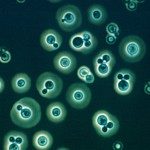Link to Pubmed [PMID] – 15482008
Rev Iberoam Micol 2001 Mar;18(1):12-6
Utilization of L-sorbose, D-arabinose or primary fluconazole resistance in Candida albicans are controlled by copy number of specific chromosomes. On the other hand, spontaneous morphological mutants have a wide range of chromosomal alterations. We have investigated the UV and X-ray sensitivity of these mutants, as well as C. albicans laboratory strains. While L-sorbose utilizing mutants had normal sensitivities, a large subclass of D-arabinose utilizing mutants was abnormally sensitive to UV. Spontaneous morphological mutants responded differently, an expected result because of the heterogeneous nature of their electrophoretic karyotypes. We suggest that the differences in UV and X-ray sensitivity are due to gene imbalance caused by some chromosomal alterations. In this respect, the radiation sensitivity is similar to other features impaired by changes in chromosomes, but is unlike the acquisition of the ability to utilize alternative nutrients or the acquisition of resistance to fluconazole. Our studies also revealed that strains of C. albicans heterozygous for the mating type loci exhibited the same X-ray sensitivity as homozygous or hemizygous strains, a finding which is in contrast to the properties of Saccharomyces cerevisiae, where heterozygous strains are more resistant. This feature of C. albicans strains may be indicative of an inefficient repair system that may be related to inefficiency of mating.
